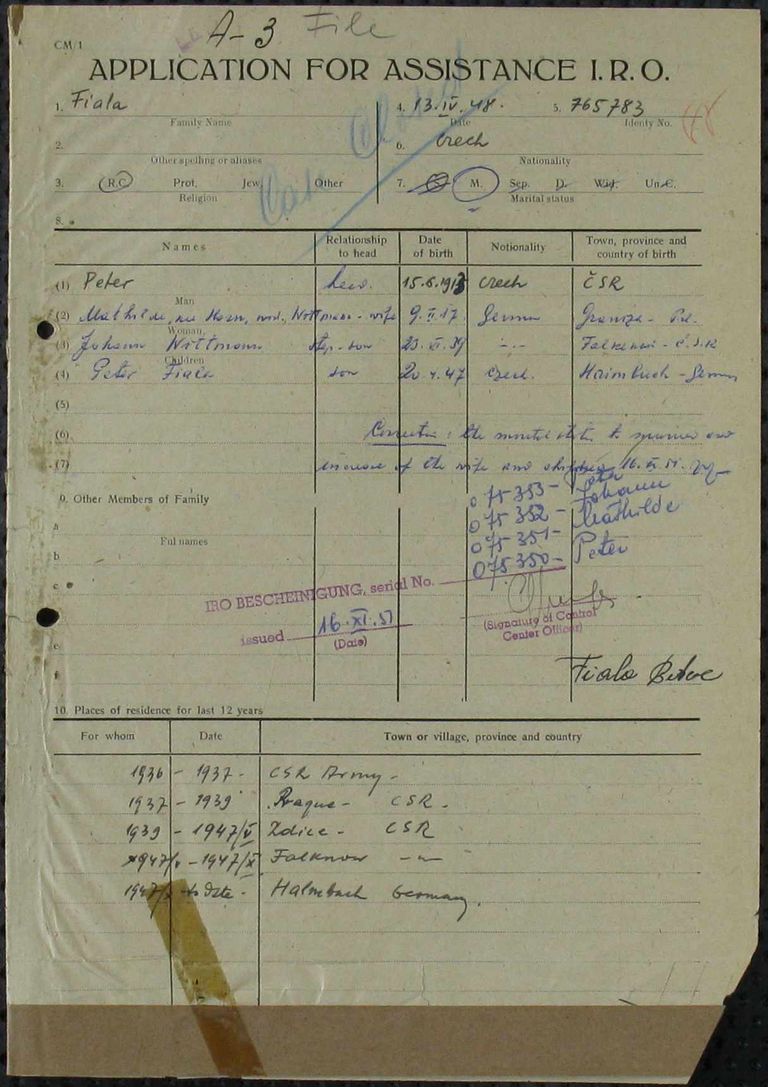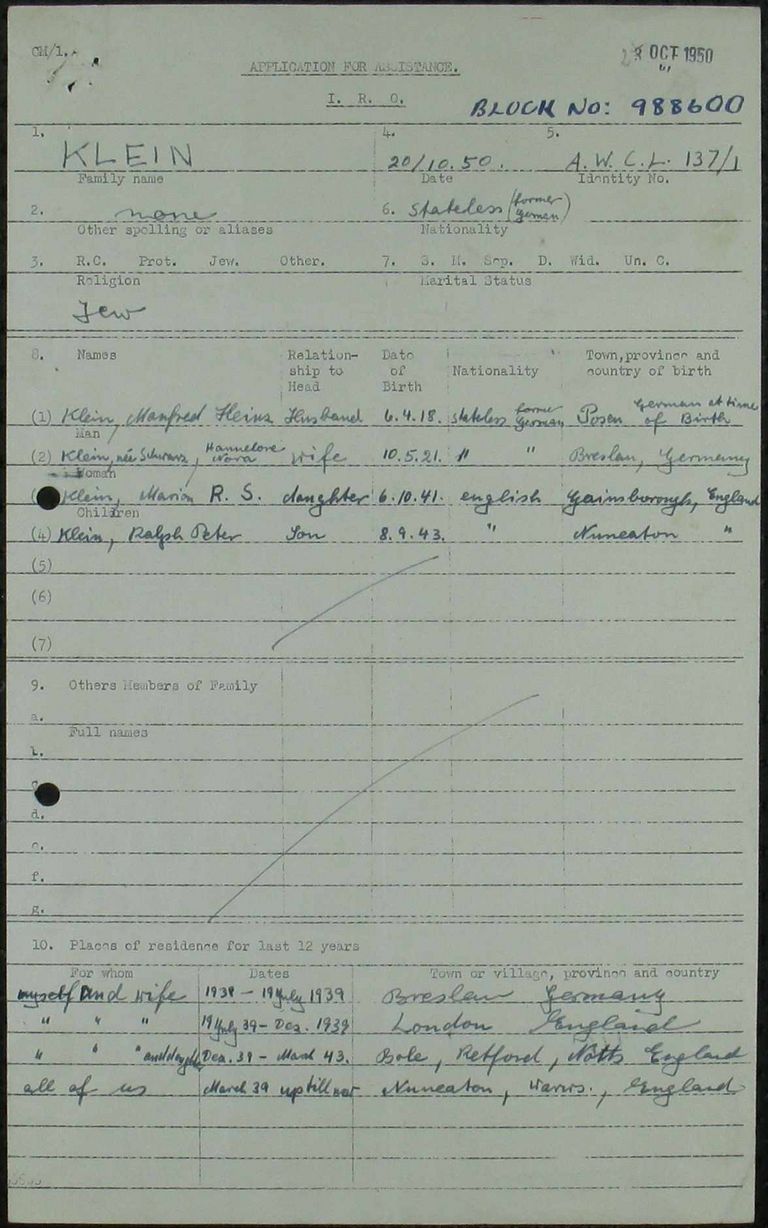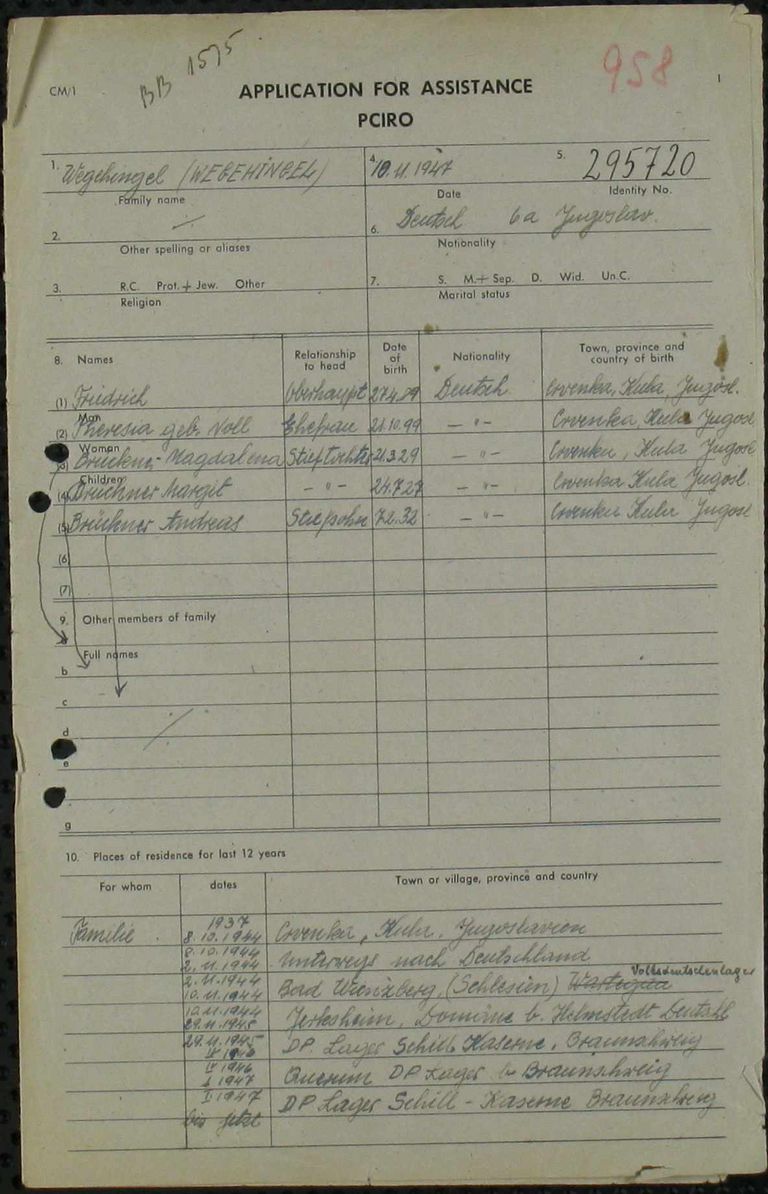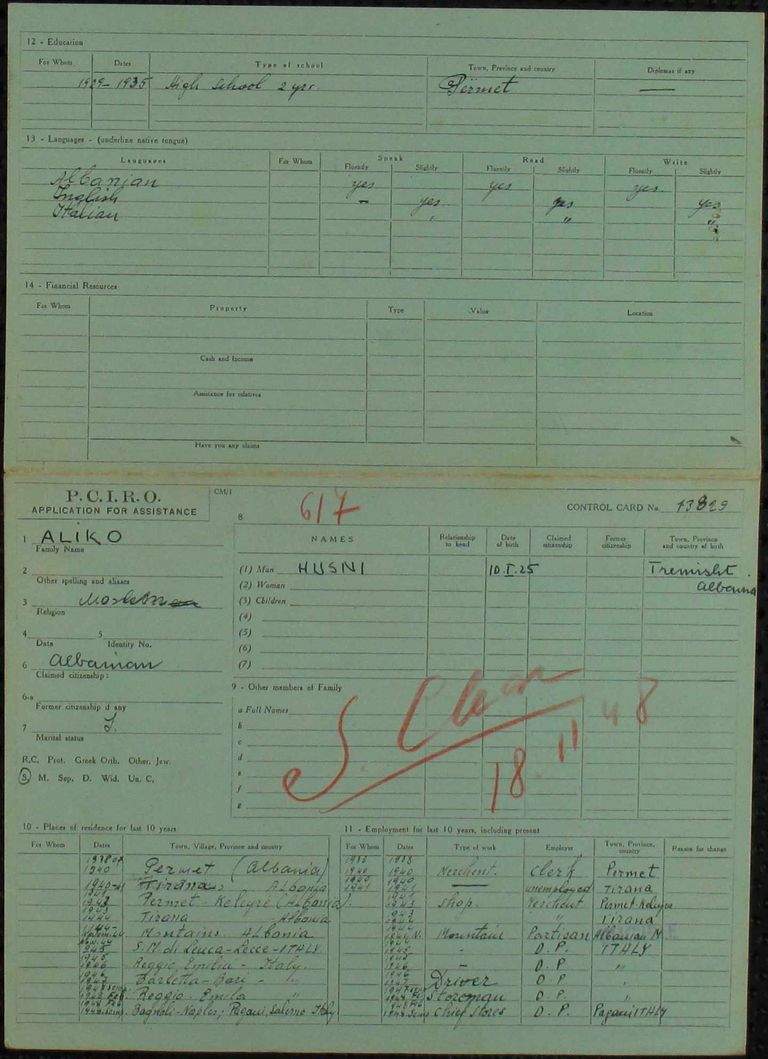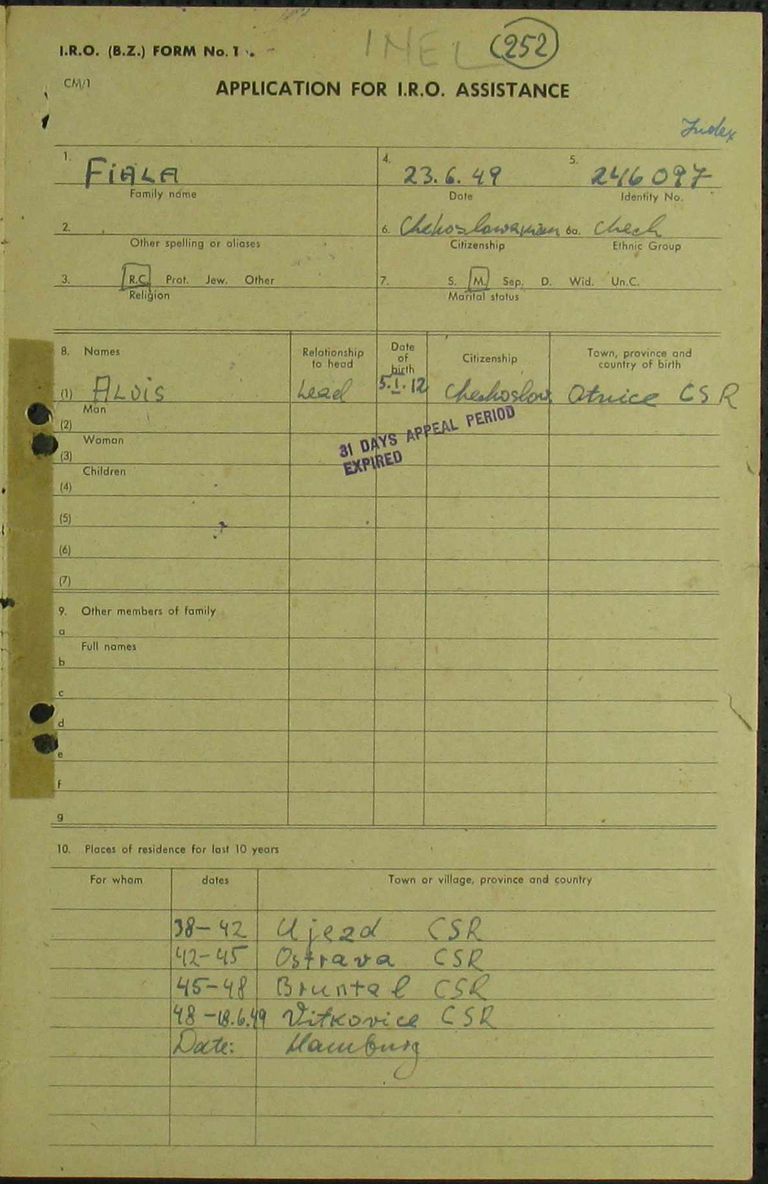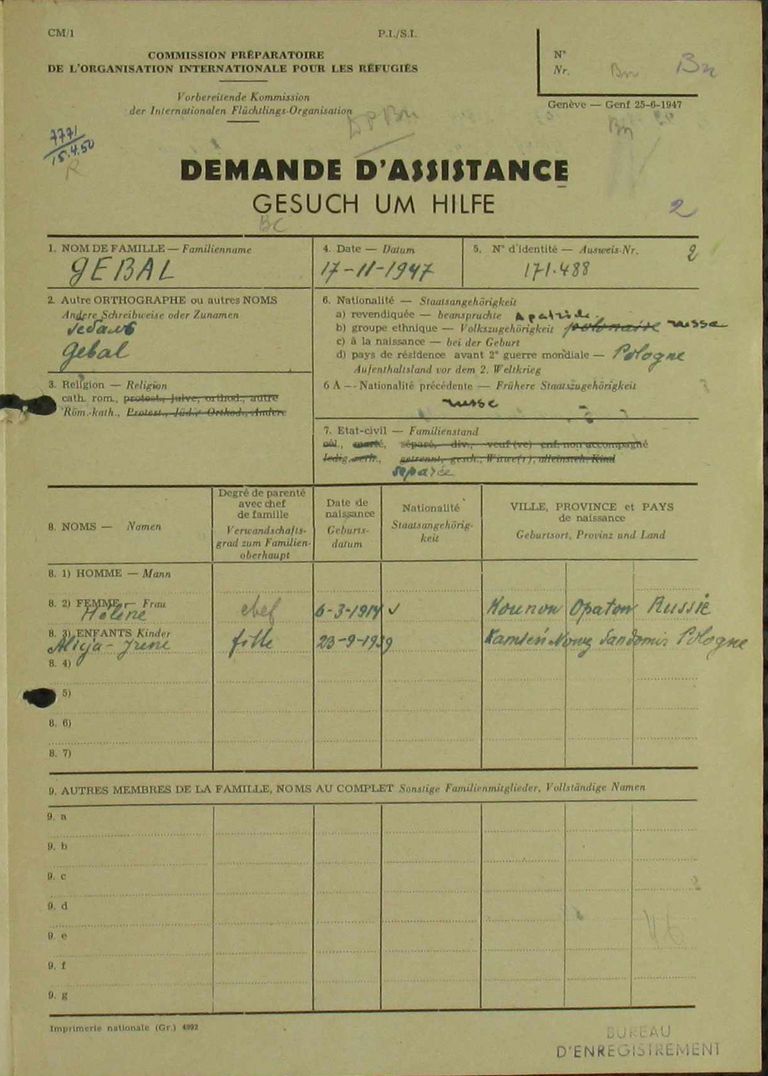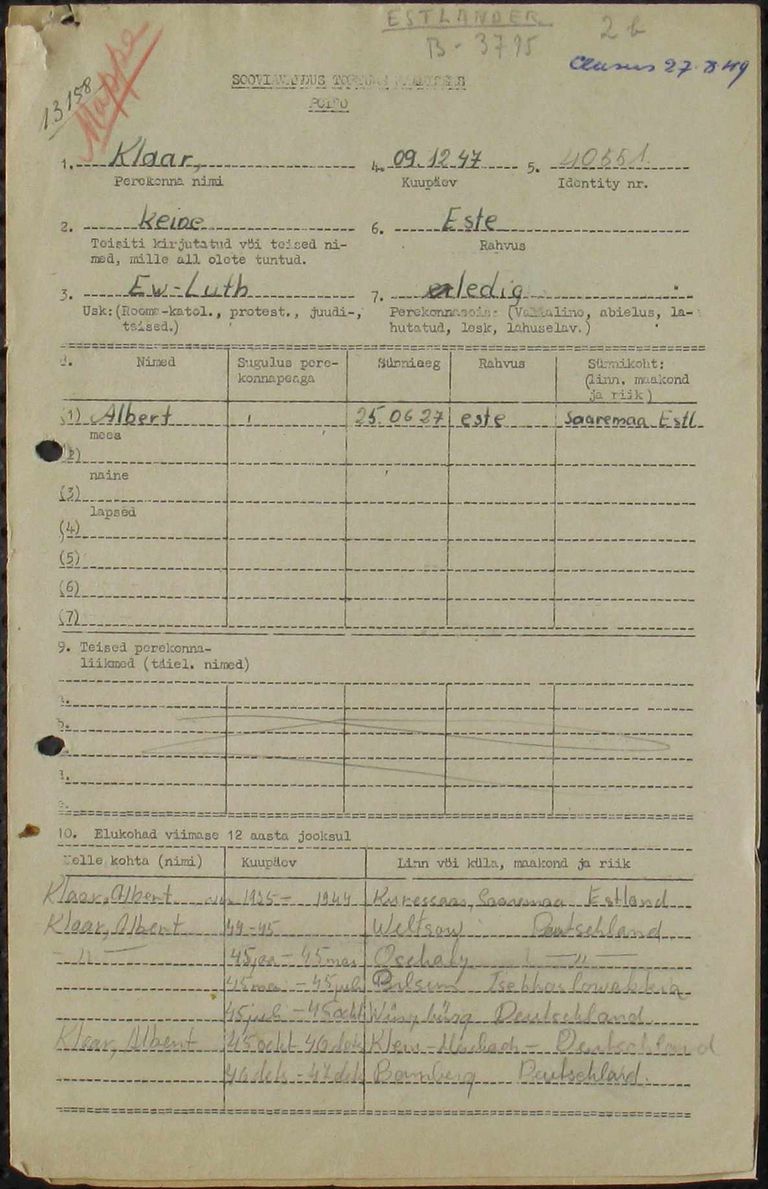Page of
Page/
- Reference
- Intro
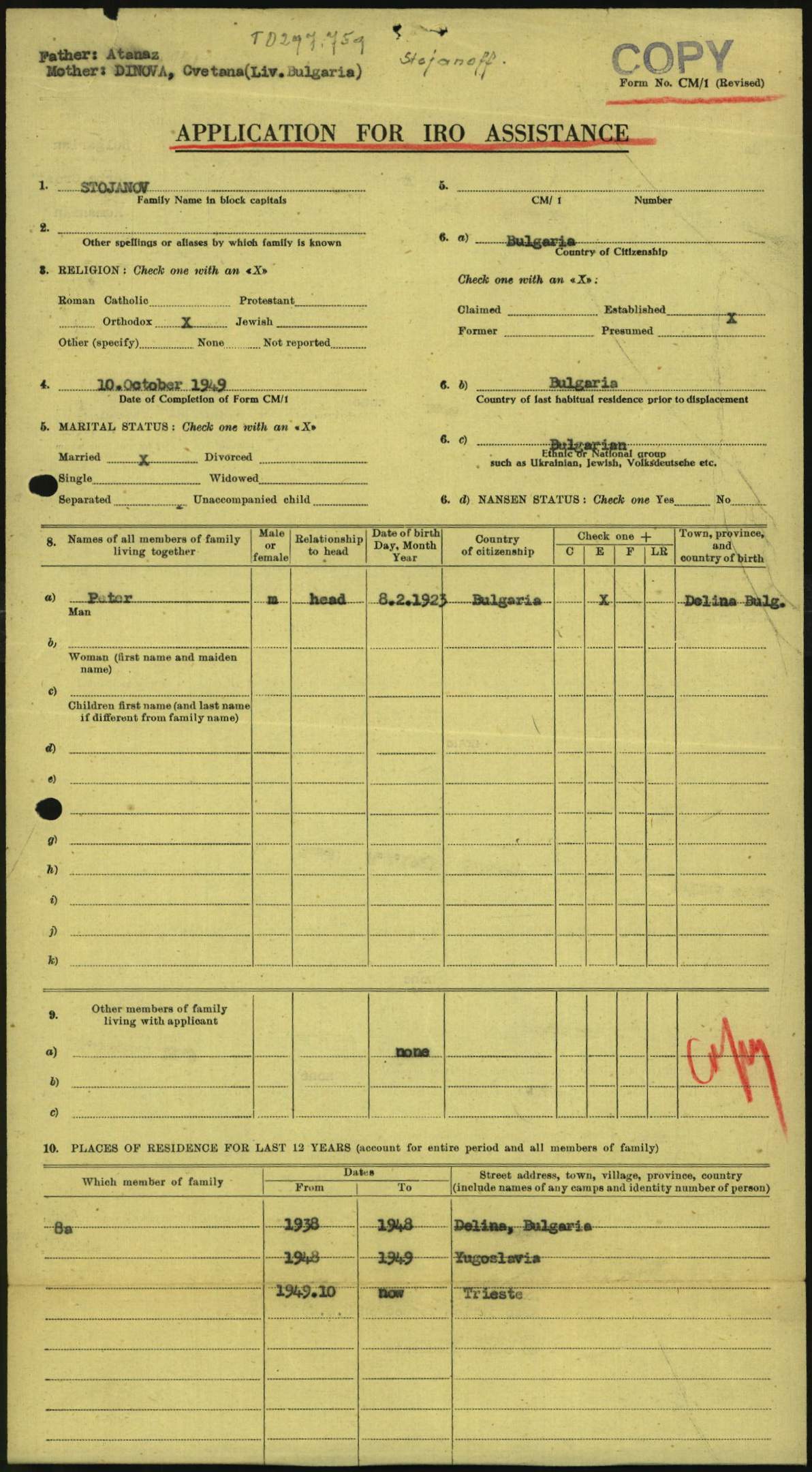

When the IRO took over responsibility for caring for the DPs in July 1947, IRO employees conducted a review of all DPs. In order to receive support, the DPs had to answer questions about themselves on a four-page form. To this day, the Application for IRO Assistance is known as the CM/1 form or CM/1 application on account of the abbreviation for this document type.
The wording and look of the forms changed slightly over time and in the individual occupation zones, but the purpose of the form and the questions on it fundamentally remained the same.
When the IRO took over responsibility for caring for the DPs in July 1947, IRO employees conducted a review of all DPs. In order to receive support, the DPs had to answer questions about themselves on a four-page form. To this day, the Application for IRO Assistance is known as the CM/1 form or CM/1 application on account of the abbreviation for this document type.
The wording and look of the forms changed slightly over time and in the individual occupation zones, but the purpose of the form and the questions on it fundamentally remained the same.
Questions and answers
-
Where was the document used and who created it?
The Application for IRO Assistance – also known as CM/1 application based on the document abbreviation – marked a change in how the Western Allies dealt with Displaced Persons. Instead of returning them to their countries of origin (repatriation), the IRO began arranging for DPs to emigrate to different countries when it took over responsibility for them from UNRAA in July 1947. In the confusion immediately after the war, UNRRA employees had initially treated people as DPs without checking their status. But now the IRO started to review who was receiving how much support. Whether a person was eligible for support depended on a number of factors, primarily their nationality and life journey. To clarify this, all DPs in the French, British and US zones, in Austria, Switzerland, Italy, the UK and even countries such as Egypt, India, Palestine/Israel, Syria, Lebanon, Turkey and East Africa had to fill out a CM/1 application – either directly for themselves or as a family. IRO employees or DPs working as registrars then carried out a preliminary check. After this, IRO eligibility officers (also known as control center officers or area welfare officers) interviewed the applicants on the basis of the CM/1 form and noted their decision on the application. Finally, chief eligibility officers reviewed all successful applications again. Over the years, the forms changed slightly in the various zones and were adapted to new circumstances.
- When was the document used?
The IRO distributed CM/1 forms from the summer of 1947, when its DP support program was launched. The CM/1 applications were used until the IRO was dissolved at the end of 1951.
- What was the document used for?
When World War II came to an end, the Allies had clear ideas about how to support the DPs. After being registered and receiving food, clothing and medical care in the DP camps, they were to be taken back to their countries of origin. By the time the IRO took over responsibility for the DPs from UNRAA in July 1947, however, the situation looked different. Most of the around 700,000 DPs who were cared for by the IRO could not or did not want to return to their countries of origin. As a result, less and less DPs needed to have repatriation arrangements made. Instead, IRO employees increasingly helped DPs emigrate to different countries in the context of the Care and Maintenance program. Among other things, they offered foreign language classes and vocational courses for the DPs. The IRO also arranged for schooling and medical care, and it assisted with the formalities of the emigration process. The important factor was that assistance was only to be provided to DPs within the mandate of the IRO. To determine whether a person was eligible, the IRO questioned the applicants extensively using the CM/1 form.
The questions on the CM/1 application were diverse. The applicants had to explain where they had been in the last 10 or 12 years and where they had worked, but they were also asked about their future plans and why they were not returning home. At the same time, they had to describe their current situation: What financial resources did they have for emigrating? Were they working at the moment, and if so, how much were they earning? What kind of professional and language skills did they have? And what connections did they already have with other aid organizations?
In addition to the CM/1 applications and accompanying supplementary sheets, the applicants submitted many other documents, such as certificates of death, birth and marriage, passports, and professional certificates. These were gathered together in CM/1 folders. ITS employees later removed the original documents from the folders and sent them to Office of the United Nations High Commissioner for Refugees (UNHCR). This office was supposed to return them to their rightful owners, which is why the documents have not been preserved in the Arolsen Archives.
Based on the information in the CM/1 application, the supplementary documents and the interview, eligibility officers decided whether the applicants could be accepted into the Care and Maintenance program of the IRO. This decision – together with additional commentary – is usually written or stamped on the CM/1 forms. The 163-page Manual for Eligibility Officers reveals just how complex the decisions were. The IRO laid out the ground rules in this manual: In order to be recognized and supported by the IRO, a person had to have been persecuted for political, racist or religious reasons by the Nazis or other governments allied with them. There were many restrictions, however. The eligibility officers made a basic distinction between applicants “within the mandate of the organization” (WMO), meaning those who were the responsibility of the IRO, and applicants “not within the mandate of the organization” (NWMO), meaning those who did not meet the criteria established by the IRO. Formulations such as “ineligibility,” “ineligible for IRO assistance” and “No refugee, no D.P.” can also be found on CM/1 applications for the latter group.
Even after a CM/1 application had been fundamentally approved, however, various types of support would be provided. This is evident from the different stamps on the CM/1 forms. The IRO could arrange for DPs to return home (“eligible for repatriation”), help them emigrate (“eligible for resettlement” or “discretionary resettlement assistance” – DRA for short), or make it possible for them to settle in their current location (“eligible for re-establishment sur place”). IRO employees could also stamp the restriction “legal and political protection only” on the CM/1 application. In these cases, the IRO took over tasks that would otherwise be the responsibility of the government and authorities of a DP’s country of origin. Above all, they asserted the rights of the DPs when these had been restricted by other authorities. Fundamentally, all individuals recognized as DPs were eligible for legal and political protection by the IRO. The stamp “legal and political protection only” is therefore found only on the CM/1 applications of DPs who did not receive any additional assistance. The extent of the support provided could often change, however, which is why the validity date for a DP’s status is often noted as well.
The applicants were told that the information they provided on the CM/1 application would be checked by IRO employees in the Document Control Sections and Control Centers. For example, the applications would be compared with other documents about the same person held by the International Tracing Service (ITS). In order to find collaborators who had cooperated with the Nazis, the Berlin Document Center and Wehrmachtauskunftstelle (Wehrmacht Information Office or WASt) sometimes also checked whether there was any evidence that an individual should not be accepted into the IRO program. German registration offices were also contacted mainly for information about former forced laborers.
The applicants always had the right to appeal. If they did not agree with the decision of the eligibility officer, they could request to have their status checked again by the IRO review board in Geneva. The decision letters for over 32,000 applicants who asserted this right have been preserved in the Arolsen Archives.
When the IRO disbanded at the end of 1951, the CM/1 applications were used for a different purpose. After the CM/1 applications and other documents had been handed over to the ITS, West German reparation authorities began to request them. They wanted to know what the people who had applied to them for compensation had written in their CM/1 applications. The authorities assumed that the CM/1 applications were a reliable source of data. ITS employees primarily checked the CM/1 applications and DP 2 cards and passed on the information. Today, the personal files that were created in the context of the Care and Maintenance program are available to researchers in the online archive of the Arolsen Archives. “Transnational Remembrance” is a project based on 1,000 CM/1 applications which shows the life journeys of former forced laborers on an interactive world map.
- How common is the document?
An ITS list from 1996 records the existence of 350,000 CM/1 applications or folders. Most of these came from the three western occupation zones of Germany (around 199,000 folders). However, there are also CM/1 applications filled out by people in Austria (around 40,500 folders) and Italy (around 30,600 folders). The collections from Switzerland (around 33,500 folders) and England (around 9,200 folders) were also created in the context of the IRO’s Care and Maintenance program, but these folders generally hold letters instead of CM/1 applications. It is important to note that not all of the applications in the “England collection” relate to applicants in the UK. There are also many CM/1 applications from people who requested support from outside of Europe, such as Lebanon, Syria and East Africa. The Arolsen Archives also have around 32,000 letters from the Geneva office of the IRO in which applicants appealed against the decision of the IRO.
A total of around 850,000 people are mentioned in all of the files associated with the Care and Maintenance program. Although this number is high, not all of the CM/1 forms that were ever filled out have been preserved. This is mainly because IRO employees used to destroy the documents as soon as the DPs had emigrated and therefore no longer needed assistance. The destruction process stopped when the German reparation authorities realized how important the documents were and asked for the files to be preserved.
The ITS began receiving shipments of CM/1 applications in the early 1950s. The largest shipment of around 300,000 forms arrived at the ITS in December 1952 together with a total of 32 tons of other DP documents, including more than one million DP 3 cards. In January 1952, after the IRO had been disbanded, these CM/1 forms were first handed over to the Office of the United Nations High Commissioner for Refugees (UNHCR). They were sent from there to the ITS and are now stored in the Arolsen Archives.
- What should be considered when working with the document?
The information in the CM/1 applications comes from the applicants themselves. It therefore comprises the details that they could remember, that they wanted to share or that they did not deliberately hide. For any number of reasons, there may be discrepancies when the CM/1 files are compared with other documents for the same person. For one thing, many applicants no longer had any of their own documents, either because they had lost them during their years of persecution or because the documents had been taken from them. The applicants therefore often had to provide information from memory. Furthermore, applicants sometimes deliberately left out certain details on the CM/1 form because they feared they would otherwise not receive support from the IRO. Additionally, the Control Center employees were required to accept and check every CM/1 application submitted to them. For this reason, the Arolsen Archives also hold applications from people who were not DPs. Despite these limitations, the CM/1 applications have a special importance, namely, they gave people the opportunity to describe their lives in their own words and to define themselves. It is particularly notable that the forms were not multiple choice but instead consisted of empty fields to be filled out by the applicants.
Another noteworthy aspect is how the ITS referred to the CM/1 applications. Even though only the individual form itself was the CM/1 application, the term was often used by the ITS for the entire folder. However, the folders hold many different documents. Along with the envelope created by ITS employees and the actual Application for IRO Assistance (CM/1), the folders include other forms from the Care and Maintenance program: forms for the Discontinuance of IRO Assistance (CM/2), for a Change of IRO Status (CM/3), Records of Interview (CM/4) between the applicants and eligibility officers, and forms for the distribution of clothing (CM/d2). Since the applicants’ DP status was reviewed in connection with the IRO’s Care and Maintenance program, all documents were labeled with the abbreviation “CM” for Care and Maintenance. Other forms for supplementary information and amendments, earlier screening questionnaires from UNRRA, and medical records may also be included, so some of these folders are very extensive. Nonetheless, the folders now held in the Arolsen Archives are no longer complete. According to a report from 1953, ITS employees removed the correspondence between the IRO and the applicants from the folders and sent the original documents, such as birth certificates, back to the UNHCR. The folders were therefore reduced to about half their former size. At the same time, however, when ITS employees reorganized the collection, they also added documents to the folders that related to the respective person but came from different sources.
If you have any additional information about the CM/1 applications, we would appreciate it very much if you could send your feedback to eguide@arolsen-archives.org. New findings can always be incorporated into the e-Guide and shared with everyone.
Help for documents
About the scan of this document <br> Markings on scan <br> Questions and answers about the document <br> More sample cards <br> Variants of the document
